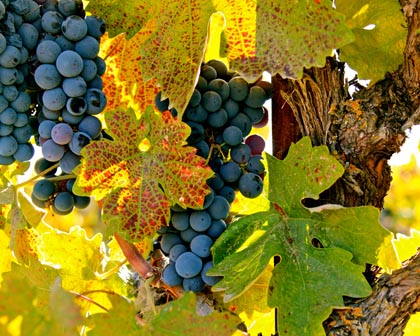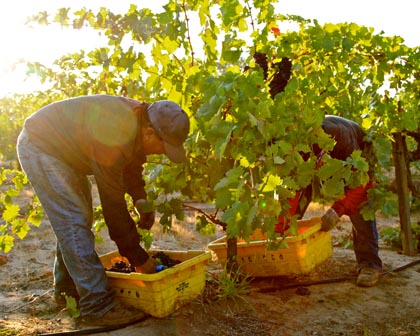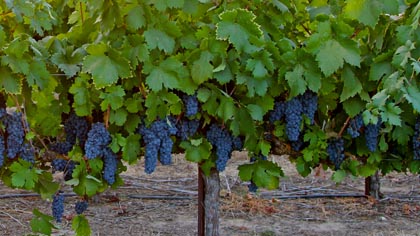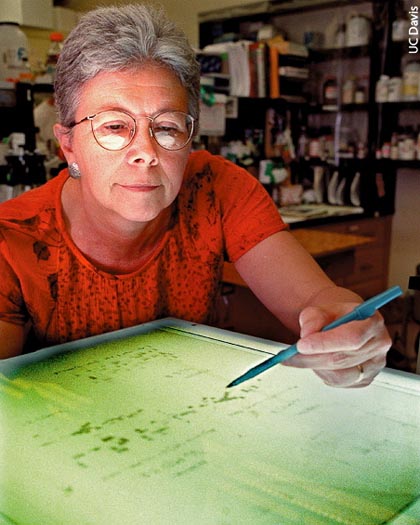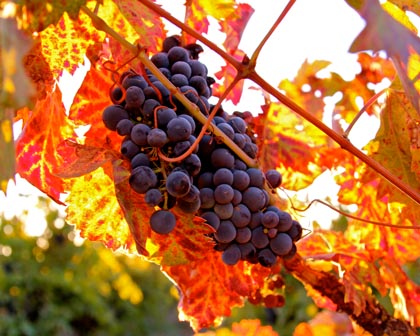Letters from Lodi
An insightful and objective look at viticulture and winemaking from the Lodi
Appellation and the growers and vintners behind these crafts. Told from the
perspective of multi-award winning wine journalist, Randy Caparoso.
The mystery of Zinfandel, part 1: a plot as thick as the wine
Kirschenmann Vineyard Zinfandel; east side of Lodi’s Mokelumne River AVA
For the longest time, Zinfandel was known as California's "mystery grape." It has also been long considered an “all-American” varietal; since as far as anyone knew, Zinfandel wasn't grown anywhere else in the world. Make that “all-California,” because virtually all of it is grown in the state of California – and most of that, in the American Viticultural Area of Lodi.
Whatever the case may be, America loves Zinfandel – whether it is made into a light, fizzy, fruity pink wine (i.e. White Zinfandel), or a moderate to humongously full, thick, lip-smacking red wines. This black skinned grape is successfully cultivated up and down the state, from the warm regions of the Central Valley to the windy, bone chilling ridgetops of Mendocino.
Zinfandel has long been considered a uniquely American wine because nowhere else in the world has it been produced with so much success. Since the mid-1800s, when it was first established as one of California’s dominant grapes, growers have known that Zinfandel originated from the same European family of grapes, called Vitis vinifera, to which varieties like Chardonnay, Cabernet Sauvignon, Riesling and Pinot Noir also belong. But for most of the past century, no one knew exactly from which part of Europe Zinfandel originated.
Harney Lane’s Lizzy James Zinfandel harvest
During a visit to Italy in 1967, however, a U.C. Davis plant pathologist named Austin Goheen took note of a vine grown in Italy's Apulia region that bore an outward resemblance to Zinfandel. In Southern Italy, this grape was called Primitivo. But even in Apulia, Primitivo was largely unappreciated: at the time it was used primarily for anonymous blending into other red wines, mostly by wineries located in Northern Italy (similar to the way Lodi grown Zinfandel was historically used by wineries in Napa Valley and Sonoma County to bolster their wines).
Cuttings of Primitivo were brought back to the U.C. Davis for further study in 1968; and although the viticultural professors were fairly certain that Primitivo was the identical to California's Zinfandel, it was not until 1993 that DNA profiling techniques established this fact beyond a shadow of a doubt: Zinfandel and Primitivo are two clones of the same grape.
Ah, but it is here where the plot thickens, like a hefty bottle of Michael David's Earthquake Zinfandel. Initially, growers in Southern Italy told the American ampelographers (i.e. grapevine botanists) that Primitivo was a relatively new grape for Italy: probably first planted in Apulia in the mid- to late 1800s – that is, not much longer than in the U.S. However, more recent findings, as you can read on U.C. Davis' Foundation Plant Services Web site, are now indicating: The first recorded presence of the Primitivo grape in Italy was in Gioia del Colle, a small town in the Puglia region, around 1800. Still, the question remains: If Zinfandel/Primitivo did not originate in Apulia, where did it come from?
Primitivo in Harney Lane Winery estate
Following a clue furnished by a Dr. Lamberti of Bari (in Apulia, Italy), in 1977 Professor Goheen crossed over the Adriatic Sea to Croatia, where he obtained cuttings of still another strikingly Zinfandel-like vine, known there as Plavac Mali. But back home at U.C. Davis, Goheen was never able to conclusively establish a direct link between Plavac Mali and Zinfandel: the two plants bore a strong resemblance, but were not exactly the same. This, however, did not prevent some enterprising importers from jumping the gun – in the 1990s a number of Plavac Malic based red wines were erroneously marketed in the U.S. as Zinfandel.
U.C. Davis’s Carole Meredith
Enter Carole Meredith, the prominent grapevine geneticist. It was Meredith's team who would eventually establish the fact that Zinfandel and Primitivo were identical grapes. Thanks to funding from ZAP (Zinfandel Advocates & Producers) and the advisory of two Croatian colleagues, Meredith was able to travel to Croatia and collect 150 samples of Plavac Mali from up and down the Croatian coast as well as some from nearby islands.
Subsequent research at U.C. Davis seemed to prove only one thing: there was a relationship between Zinfandel and Plavac Mali, but it entailed one being the offspring of the other. It took a few years to untangle the chromosomal knot; but in 2000 Meredith’s team was able to establish that one of the parent grapes of Plavac Mali was indeed Zinfandel/Primitivo. Soon after, on the other side of the world, the University of Zagreb's Ivan Pejic and Edi Maletic determined that Plavac Mali's other parent grape was a grape called Dobricic, which they found on an Adriatic island called Solta… and this is where the plot takes another twist.
Meanwhile back at the ranch – that is, the Republic of Croatia – in December of 2001 Professor Pejic stumbled upon still another obscure Croatian variety called Crljenak Kaštelanski (kastela red), from a sampling of just nine vines practically buried among thousands of other plants in a vineyard owned by Ivica Radunic. Pejic's initial DNA analysis seemed to indicate that an identical European match for Zinfandel/Primitivo had finally been found, in this vineyard located in the Croatian town of Kastel Novi.
More exhaustive, follow-up studies by Meredith in U.C. Davis soon confirmed Pejic's discovery: Zinfandel/Primitivo is identical to Crljenak Kaštelanski; thereby conclusively establishing the grape's Croatian heritage. In fact, Professor Meredith has referred to the grape as “ZPC,” for Zinfandel/Primitivo/Crljenak Kaštelansk. Mystery solved.
Or is it? Professor Meredith most recently reports that a 90-year old preserved herbarium specimen of a grape called Tribidrag was recently found in a museum in Split, Croatia, and subsequent DNA testing by Dr. Pejic has shown it to be identical to Zinfandel. In the most recent edition (2012) of Jancis Robinson's book, Wine Grapes, Tribidrag is now given as Zinfandel’s official name; and a historian named Ambroz Tudor has uncovered references to Tribidrag dating back to the 1400s. So what's it to be – "ZPC" or "ZPT"? Don't touch that dial…
Finally, Professor Meredith herself does not rule out other possibilities: in recent interviews she has said that Crljenak Kaštelanski may have actually been brought into Croatia from Albania or Greece. Will this story have a sequel?
We shall see. Meanwhile, if anything, we can at least take comfort in at least one salient fact: that the finest California Zinfandels in the world are indeed grown in California.
Please see The Mystery of Zinfandel, part 2 - the long strange trip from... somewhere.
Mystery Zinfandel; Lodi’s Mokelumne River AVA
